“There was Kudeyar-ataman”
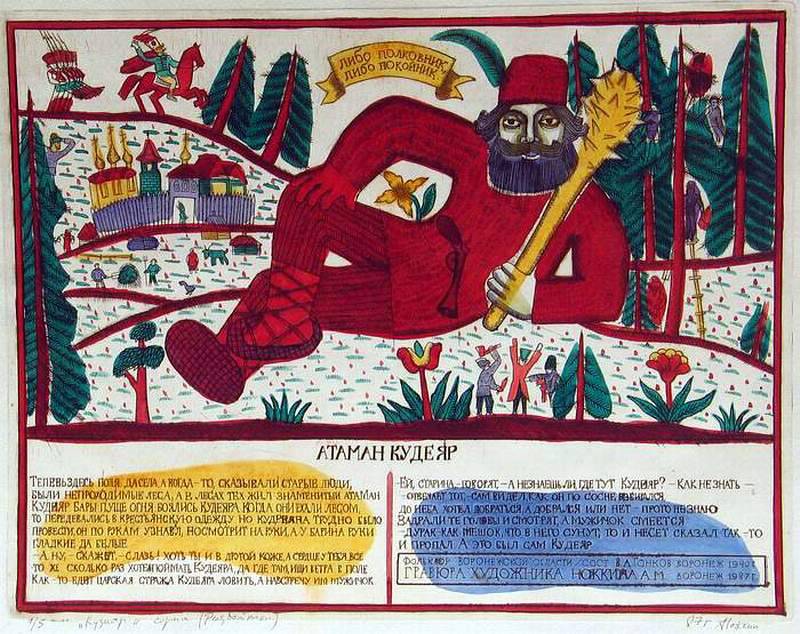
Kudeyar in a drawing stylized as a popular print by A. Nozhkin
Currently, many people know about Kudeyar only thanks to N.A. Nekrasov, who included a story about this robber in the textbook poem “Who Lives Well in Rus'” (chapter “A Feast for the Whole World”). Meanwhile, legends and traditions telling about the “exploits” of this chieftain were also popular at the beginning of the XNUMXth century. In many Russian provinces they showed places supposedly associated with him.
Legends often call Belyov and its surroundings (currently a regional center in the Tula region) the birthplace of Kudeyar. And the Kudeyarov Mountains are in the Saratov, Ryazan, Tula, Oryol and Voronezh regions. There are even more (about a hundred) tracts and “Towns” with the same name.
Only the legends and songs about Stepan Razin were more beloved by the people. By the way, the most famous and still very popular song about Razin is “The Cossack Parable,” recorded 200 years after his execution - in the 1880s. from the “75-year-old Cossack man”:
Yes on the east side,
Yes, they tore off the dark cap
Oh, yes, from my wild head.
A esaul was talkative,
He dared to unravel my dream.
Oh, it will disappear, he said,
Your head is wild."
Being real historical a person whose life and fate we know from many completely reliable sources, in the people's memory Razin remained not only a dashing ataman, but also an intercessor against the tyranny of the boyars and royal governors. And Alexandre Dumas, having heard stories about the famous chieftain during a trip to Russia, in his notes called him “a real legendary hero, like Robin Hood.”
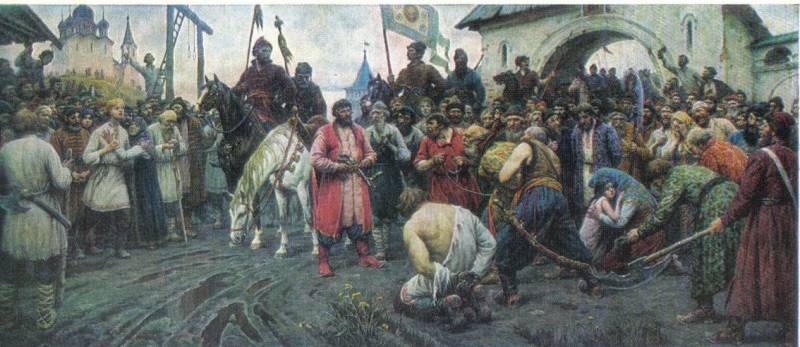
Shcherbakov B.V. Stepan Razin in the center of the painting “The People's Court”
Despite all the efforts of the authorities, the people remembered and waited for Razin. An old man who remembered Pugachev said to the historian N. Kostomarov:
Legends claimed that, waiting in the wings, Stepan Razin was languishing in one of the shihans - this is the name of lonely hills or small mountains in the Volga region, the Cis-Urals and Trans-Urals.
In the photo is the Bashkir shihan Yuraktau:

Unlike Stepan Razin, Kudeyar looks like a purely folklore character. His identity could not be reliably identified. But one historical document, dated 1640, allows us to determine the time of his robber “exploits”. The Tula governor reports to Alexei Mikhailovich:
That is, this chieftain probably robbed in the second half of the XNUMXth century.
Some features of Stepan Razin were transferred to Kudeyar. For example, popular rumor declared Razin to be a sorcerer: he supposedly “commanded the devils,” “he knew such a word that cannonballs and bullets bounced off him,” and “it was impossible to take him by any army.” And some legends about Kudeyar explain the success of this chieftain with witchcraft abilities. Numerous legends about enchanted treasures are associated with the name of Razin - and similar stories were told about Kudeyar.
But in folk legends, Kudeyar still usually appears not as a people’s defender, but as an ordinary successful (and very cruel) robber. Only sometimes does he suddenly acquire the features of Robin Hood - he robs and kills landowners and boyars, and shares the spoils with the poor. And the Old Believers even called Kudeyar “defender of the faith.”
In the Solovetsky Monastery they said that an old robber took monastic vows here and became a monk. In the unpreserved cemetery of this monastery, a slab was allegedly seen with the inscription: “Monk Pitirim, former Kudeyar, is buried here.” But in the Sevsky district of the Oryol province a legend was recorded, from which it follows that Kudeyar was not a person, but a spirit guarding enchanted treasures (“storekeeper”).
Legends are recorded where Kudeyar turns out to be a disgraced boyar, hiding in the forest from the royal wrath. In the Ryazan and Voronezh provinces, Kudeyar was often called a former guardsman.
But especially popular were the stories about the repentance of this robber and God's forgiveness, which he received after killing an even more terrible person. This is exactly the “legend of two great sinners” that Nikolai Nekrasov included in his famous poem.
An interesting suggestion has been made that Kudeyar’s popularity was greatly facilitated by thieving tsarist officials, who attributed all shortages to the robberies of this “ubiquitous elusive and invincible” ataman, with whom there was no way to cope.
Researchers are still arguing about the name of this robber.
The most popular version is that this name was derived from the Tatar Kudoyar or Khudoyar. At least, the chronicles speak of Murzas bearing that name. And some believe that this Tatar name became a household name for tax collectors, whom Ataman Kudeyar also “collected” - albeit not officially.
According to another version, Kudeyar is both a name and a nickname: Kudin Yary (Kudin in this case is a form of the church name Akindin).
There is also a more exotic version, according to which the name Kudeyar is of Persian origin: from Xudāyār - “Beloved by God.”
And some believe that Kudeyar is a nickname meaning “wizard” or “sorcerer.”
Despite the scarcity of reliable sources, attempts were made to find the prototype of this popular hero.
The hypotheses turned out to be very bold and unexpected, since in a number of cases they tried to attribute a very high origin to this robber. This still does not cause surprise, since many people still believe in the exclusivity of “noble origin,” although it is clear that those born in closely related marriages (usually with cousins or nieces) representatives of degenerate ancient families and dynasties could rather worsen "breed" rather than improving it.
Nevertheless, let's look at some of these versions.
Tsarevich?
A legend recorded in the Saratov village of Lokh in 1919 says that Kudeyar was the younger brother of Ivan the Terrible. Having received a prophecy that an older relative would deprive him of the throne, the king allegedly ordered his servants Ivan and Sim to kill the child, but they instead fled with him to the Turkish Sultan. Here the prince was converted to Islam and received the name Kudeyar.
Surprisingly, this version echoes the testimony of Sigismund von Herberstein, who also writes about the disappeared brother of Ivan the Terrible in his “Notes on Muscovy” - however, about the eldest, born by the first wife of Vasily III Solomonia Saburova:
Vasily III chose Solomonia Saburova, a relative of the Godunovs, from among one and a half thousand brides. The girl passed the strictest selection process, and at the last stage she was examined by midwives, who did not find any “female flaws” in her. But for twenty years the marriage of the Grand Duke remained fruitless, which Vasily III was very worried about: not wanting to transfer the throne to his brothers, he even forbade them to marry before the birth of an heir.
He made the final decision about divorce after meeting the 16-year-old beauty Elena Glinskaya, who came from a family of direct descendants of the Lithuanian prince Gediminas. To please her, Vasily even shaved his beard.
At that time, two church parties fought for influence on the Grand Duke - the Josephites and the non-covetous. Vasily III favored non-covetous people, but their leaders, Vasily Patrikeev and Maxim Grek, refused to consent to a divorce from their first wife and even threatened with excommunication. This led to the defeat of the non-possessors; Patrikeev and Greek were accused of heresy and imprisoned in monasteries.
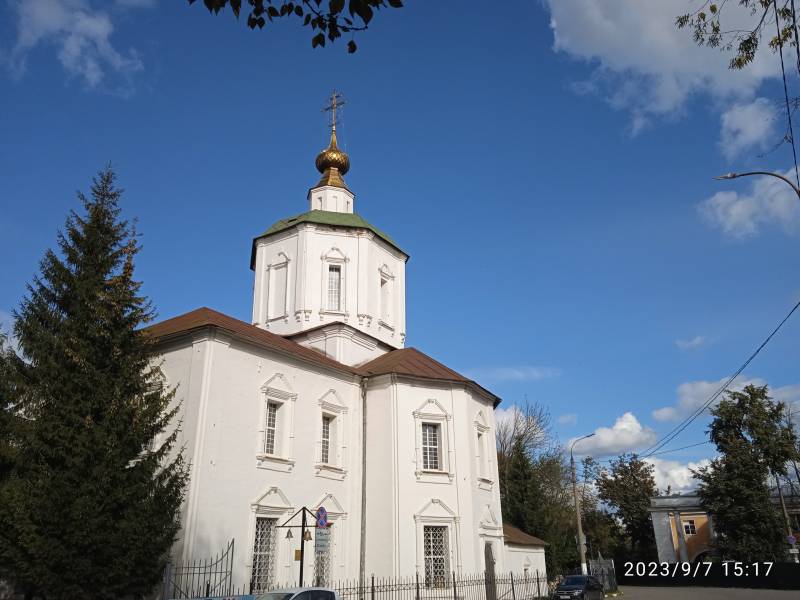
Tver, Assumption Cathedral of the Otrochev Monastery, in which Maxim the Greek was in exile for 20 years, and where Metropolitan Philip (Kolychev) was killed. Author's photo
The leader of the Josephites, Metropolitan Daniel, turned out to be not so principled and even personally performed the wedding ceremony of Vasily and Elena. He also tonsured Solomonia, and when she threw away the monastic doll, boyar Ivan Shigona-Podzhogin, according to Herberstein, “cursed her and hit her with a whip.” But soon after the wedding, rumors spread that Solomonia was pregnant. Then Vasily suddenly alienated Metropolitan Daniel and Ivan Shigona-Podzhogin, who beat Solomonia, from himself.
Solomonia was transferred to the Suzdal Intercession Monastery, where, according to legend, she gave birth to a son named George.
What follows is even more interesting. Vasily III ordered the construction of the Church of St. George to begin - and the foundation of the church in honor of the birth of his son was a long-standing tradition of the Moscow princes. Vasily did exactly the same after the birth of Elena Glinskaya’s son. In addition, an entry was found in the deposit book of the Rostov Boris and Gleb Monastery:
Vasily III had a weak-minded son, Yuri, the younger brother of Ivan the Terrible, but he was commemorated in churches and monasteries on November 26. And in April it was ordered to commemorate some other son of Vasily III.
But did Solomonia really have a son? She never showed him to the representatives of the Grand Duke, and then declared him dead. And a legend arose that, fearing for the boy’s life, Solomonia secretly sent him with faithful people to the Kerzhen forests, and put a doll in the coffin. This son of Solomonia allegedly later became the famous robber Kudeyar.
In the summer of 1934, archaeologists in the cathedral of the Suzdal Intercession Monastery opened a small tomb located next to the grave of “Elder Sophia” (under this name Solomonia was tonsured a nun). In a small, half-rotten log, a bundle of decayed rags was found, dressed in a silk shirt embroidered with pearls, and retaining the outline of the body of a child about 5 years old. This shirt can be seen in the Suzdal Historical Museum:
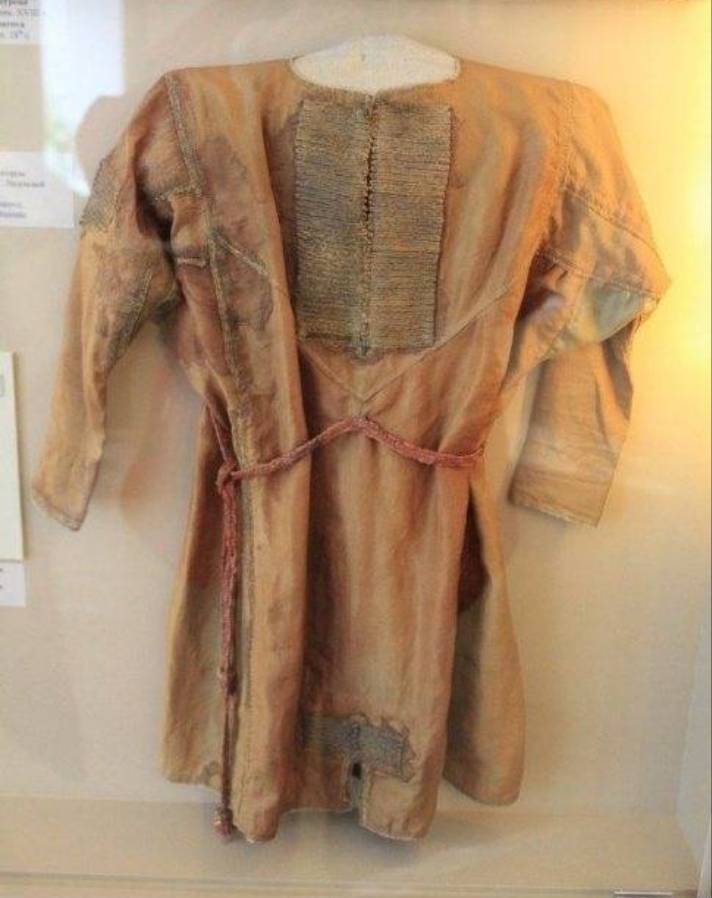
Thus, the legend about the burial of the doll instead of the supposed Tsarevich George received unexpected confirmation. However, the question of the birth of a child by Solomonia remains open.
It is quite possible that this story was invented by her as revenge on her husband who rejected her. But everything went too far, the Grand Duke probably began to demand to see a non-existent heir, and his death had to be announced. But, even if the child of Solomonia really existed and was really hidden, there is no reason to consider him the robber Kudeyar.
However, Ivan IV clearly did not like the rumors that his elder brother, the legal heir to the throne, was hidden somewhere in Rus'. And the impostor who took the name of George, as subsequent events showed, could be no less dangerous than the real prince. Some even believe that the desire, at all costs, to clarify the fate of the alleged son of Solomonia Saburova and to find either him or the impostor, was one of the reasons for the creation of the oprichnina by Ivan IV.
There is a version that Kudeyar was the grandnephew of King Stefan Batory, that is, he had some rights to the Polish throne. His father is called a certain Zsigmont Batory, who together with his son entered the service of Ivan IV.
Kudeyar, who then bore the name Gabor-Georgy Sigismundovich, allegedly served in the oprichnina, but, having fallen into disgrace, he fled and became the head of a bandit gang that “hunted” in the forests south of Moscow. As you probably guessed, historians have no documents that would confirm this version.
Other versions
In 1574, guardsman Vasily Gryaznoy, who was captured by the Crimean Tatars, wrote to Moscow about Kudyaer. From his letter it follows that in 1567 Moscow was captured by Devlet-Girey due to the betrayal of the Belyov boyar Kudeyar Prokofievich Tishenkov, who showed the enemies the fords across the Oka. Let us recall that folk legends often call Belev the birthplace of Kudeyar. However, no information is provided about the predatory activities of this traitor.
A native of the Kursk province, writer and former officer A. L. Markov, in the book “Native Nests,” came to the conclusion that the legendary Kudeyar could be Kildeyar Ivanovich Markov, who lived during the time of Ivan the Terrible, the grandson of the boyar Mark Tolmach.
In addition, according to the family legend of the Kostroma noble family of the Volkovs, the famous ataman was their relative - one of the descendants of the “noble” Litvin Grigory Volk of the Truba coat of arms, who left for Rus' from the Grand Duchy of Lithuania at the beginning of the XNUMXth century - during the reign of Vasily III. Legend also calls Kudeyar’s middle name Grigorievich.
Russian historian P.N. Petrov, author of the two-volume “History of the Russian Nobility”, also mentions a certain Pravotarch Kudeyarovich Volkov.
Kudeyar's accomplices
People's memory has also preserved the names of three prominent accomplices of the famous chieftain. A certain Sim (or Simon) died after betting with Kudeyar that he would jump on a horse from Merkulova Mountain to Kudeyarova across the Sokolka River (Saratov region). In the place where he fell and, together with his horse, sank into the ground, a spring appeared, called Simov.
Kudeyar's other accomplices are Boldyr and Anna. It was said about this woman that she threw herself into the river after the young merchant whom she loved was forced by her parents to marry a rich bride. She did not die, but only crashed and was healed by Kudeyar’s robbers. It was Anna who led the bandit gang after the ataman either died or went to repent. She died in battle on a merchant ship, which her people tried to rob. Tradition places her grave in a cave on Bad Stones (Dolomites on the steep right bank of the Don) near Dankov (Lipetsk region). And the Bad Stones are now called Anya’s Mountain.
It is also reported about Kudeyar’s wife Nastasya, who died of some illness, and their daughter Lyubasha, who is forced to guard the cave with her father’s treasure. Tradition claims that this cave is located in the Chertovo Gorodishche tract, which is located in the Kozelsky district of the Kaluga region, 30 km from the Optina Pustyn monastery. This is a hill with outcrops of sandstone rocks, inside of which there are several caves connected by narrow manholes.

Devil's Settlement
Local legend claims that from time to time Lyubasha comes to the surface and shouts: “It’s hard for me! Give me the cross!
Either to sanctify the “unclean place”, or to help Kudeyar’s daughter, the monks of Optina Hermitage twice put a cross on the Devil’s Settlement.
Treasures of the robber Kudeyar
Legends about the treasures hidden by Kudeyar are known in many areas. These treasures are considered “bewitched”; some were told that lights flash above them at night, and twice a week at midnight the plaintive cry of a child is heard from underground. But some legends claim that Kudeyar’s treasures are subject to a 200-year pledge (and its term has already expired).
In the Devil's Settlement, as we remember, the treasure is guarded by Kudeyar's daughter Lyubasha, in the caves of Saratov's Kudeyarova Mountain the ataman himself stands guard, and on Mount Cherny Yar, in the Lipetsk region (opposite the village of Dolgogo), this function is performed by his horse, turned into stone .
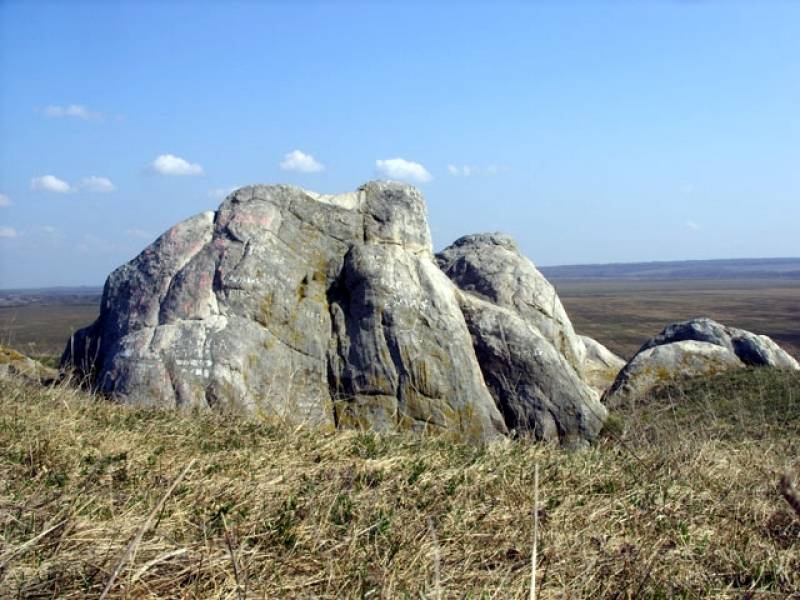
Horse stone, sometimes also called the Blue stone
Kudeyar's treasures were also placed in the Voronezh region - in the Shipovy forest near the village of Livenki, in the "Kudeyar's den" (Bobrovsky district) and in the Usmansky forest, where some peasant woman had already found a gold ring.
In the Saratov region, in the Kudeyarov town on Mount Bogatyrka, Tatar coins, pike tips, rings and daggers were found.
And there are also caves on Kudeyarovaya Mountain, which is north of the village of Lokh - we remember: it was here that a legend was recorded in which Kudeyar is called the younger brother of Ivan the Terrible.

Kudeyarova cave near the village of Lokh in the Saratov region
True, the archaeological expedition of Alexander Minkh, who worked in the vicinity of this village in the 1880s, did not find any treasures, but they excavated a grave with... a buried children's rag doll! Do you remember about the doll found in the sarcophagus of the Suzdal Intercession Monastery? A very unexpected, strange and interesting coincidence.
Kudeyarov Mountain in the drawing by A. Minha:
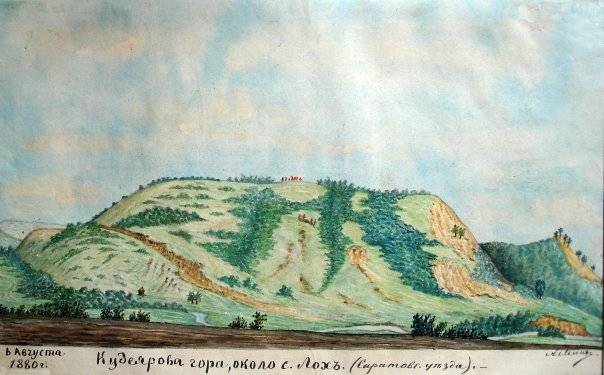
In 1893, finds made on Kudeyarova Mountain nevertheless appeared in the Saratov Museum. The meager lines of the inventory of exhibits read:
That's all the treasures. True, they talked about some peasant who found as many as 12 buckets of coins (also copper), but these are just rumors that have never found documentary evidence.
In the Tula region, treasure hunters should examine the “Kudryaviy Log” near Zadonsk, as well as the supposed grave of Kudeyar behind Kosaya Gora near Tula. You can also pay attention to the surroundings of the small town of Chekalin (Likhvin). Legends mention Kudeyar's treasures, also hidden in the Ryazan, Bryansk, Lipetsk, Oryol and Smolensk regions.
The fate of Kudeyar
Some legends claim that Kudeyar died on Mount Cherny Yar (modern Lipetsk region), where, as you remember, one of the treasures is guarded by a horse turned to stone. The Don Cossacks, irritated by the robberies of the merchants, first defeated the above-mentioned accomplice of Kudeyar Boldyr, and then besieged the ataman in his refuge on the Black Yar. Burying the treasure and leaving the horse turned to stone with it, Kudeyar tried to escape, but the Cossacks caught up with him and, shackling him, threw him into the Don.
Another version is more interesting - about the ataman’s repentance. Some claimed that he spent the last years of his life as a monk in the Solovetsky Monastery. But there is also the famous legend “About two great sinners,” which, in particular, is told by Ionushka in Nekrasov’s poem “Who Lives Well in Rus'.”
There was Kudeyar-ataman,
Many robbers shed
The blood of honest Christians...
The conscience of the villain mastered
Disbanded his band
Distributed property to the church,
Buried the knife under the willow.
And forgive sins
He goes to the Holy Sepulcher,
Wandering, praying, repenting,
It doesn't get any easier for him...
God took pity on salvation
The schemer showed the way:
An old man in prayer vigil
Some saint appeared
Rek: “Not without God’s providence
You chose the age-old oak,
With the same knife that robbed
Cut it off with the same hand!”
Kudeyar spent many years on this work, but the three-span oak tree still stood in front of him. It collapsed after Kudeyar killed the sadistic Polish nobleman Glukhovsky.
By the way, in another more common version of the folk “Legend of Two Sinners,” Kudeyar had to water a charred firebrand until it sprouts.
It is curious that the nobleman Glukhovsky from Nekrasov’s poem had a real prototype - the Smolensk landowner, about whom A. Herzen wrote in the magazine “Kolokol” on October 1, 1859; the poet did not even change his last name.
“The Tale of the Twelve Thieves” became a popular song, which was also performed by Chaliapin. The author of the music is most often called Nikolai Manykin-Nevstruev, but there is no convincing evidence of this.
I don’t know if you will be surprised to learn that the publication of the chapter “A Feast for the Whole World” was twice banned by censorship. It was published only after Nekrasov’s death - first illegally in 1879, and then in 1881 its abridged version was published in the February issue of the journal Otechestvennye zapiski. And in March of the same year, the Narodnaya Volya members executed Emperor Alexander II, who had long been sentenced to death by them.
In the second half of the 1882th century, the famous Russian historian Nikolai Ivanovich Kostomarov turned to the image of the famous robber chieftain, who in XNUMX published the novel “Kudeyar”.
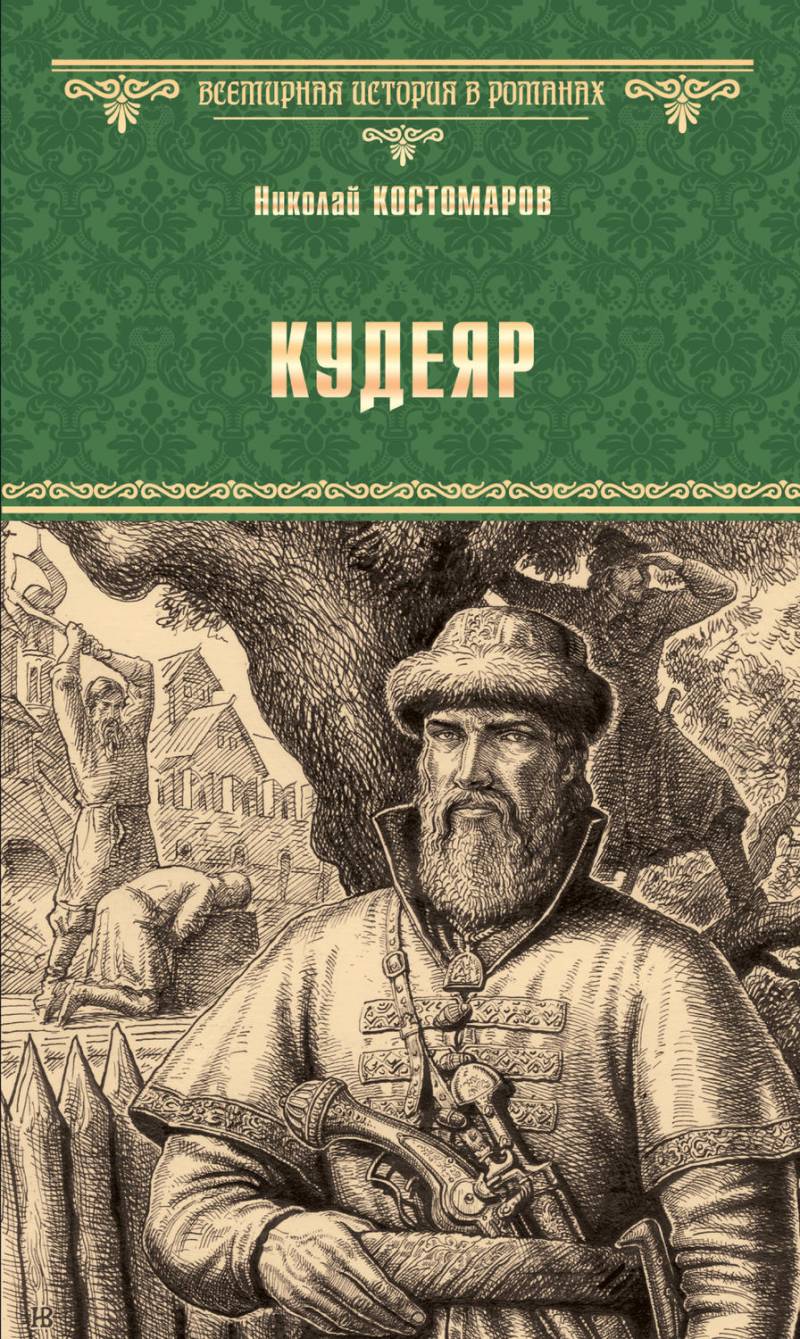
Kudeyar on the cover of the novel of the same name, written by historian N. Kostomarov in 1882.
In 2006, the documentary film “The Legend of Kudeyar” was shot at the Voronezh film studio “Filmokey”.

Film still from 2006
And in 2018, a short historical film with the same name was shot in Shatura.
Information